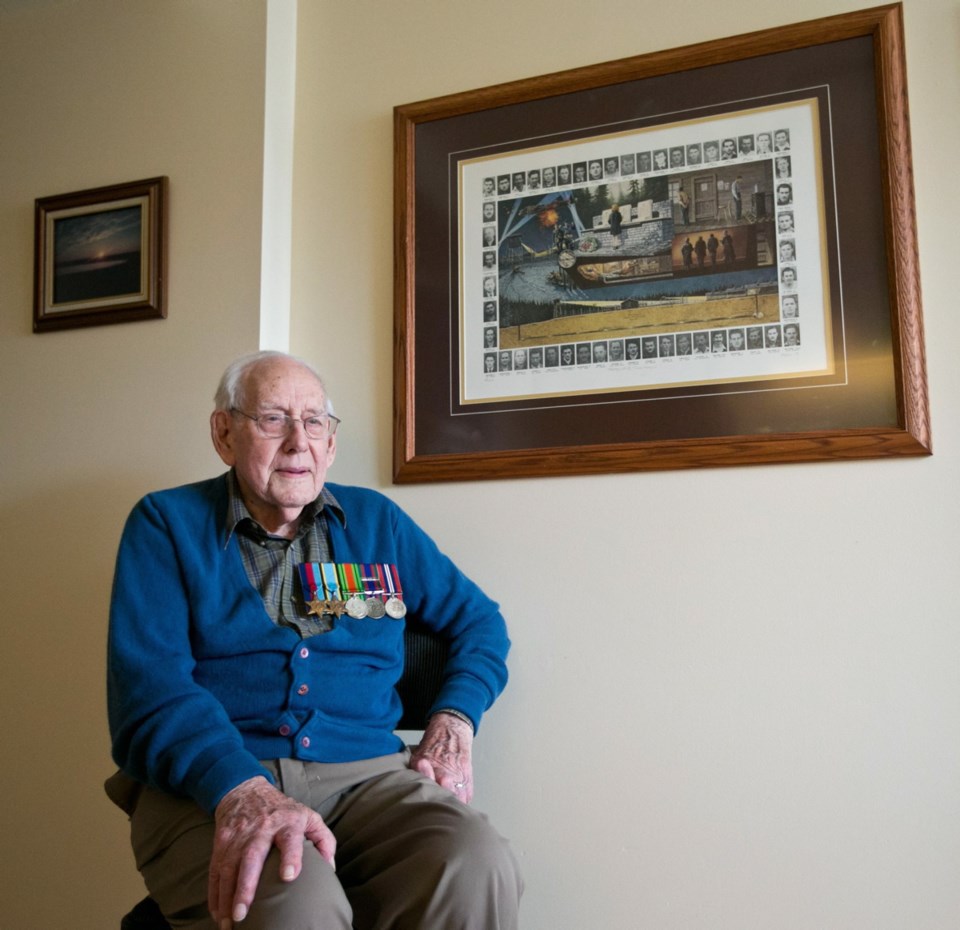Five years ago, an aging Mac Colquhoun demonstrated how he got rid of the dirt from the escape tunnel.
It was in pouches hidden inside his clothing. Strolling around the prisoner-of-war camp, Colquhoun would pull on a string — he reached into his pockets to show how he used to do it — and the sandy soil would fall out his pant legs.
That’s how the Allied prisoners got rid of the evidence while digging their tunnel. Maybe you saw that scene depicted in classic Second World War movies such as The Great Escape and The Wooden Horse, but Colquhoun actually lived it.
Colquhoun died Thursday at age 103. That was the day after another former prisoner of war, Rudi Hoenson, the Nagasaki nuclear bomb survivor, passed away at 96. A month ago it was 97-year-old Ken Curry, the very last of the 582 men of his regiment who hit the beach at Dieppe in 1942. Curry ended the war as a PoW, too.
The last of Victoria’s old boys are going quickly now, their stories going with them. Here’s Colquhoun’s as related on that day in the Veterans Memorial Lodge at Broadmead in 2015:
He was a Saskatchewan farm kid whose Royal Canadian Air Force bomber was crippled by heavy flak near Dusseldorf, Germany, one night in January 1943. Flight Lt. Colquhoun, the navigator, parachuted into a farmer’s field. Another man landed safely, too, though a third died. The other four crew members and the plane itself were never seen again.
Colquhoun eventually found himself in a Luftwaffe-run PoW camp near Sagan, now part of Poland. It’s where the escapades celebrated in The Wooden Horse and The Great Escape took place.
Colquhoun was directly involved in the former, a ballsy endeavour in which prisoners used the plywood from Red Cross crates to build a gymnastics horse, which each day several men would carry to the same spot in the prison yard — right over the hidden entrance to a tunnel. Stuffed inside the exercise apparatus were one or two prisoners who would do the digging, carefully covering the tunnel entrance before being carried back inside with that day’s excavated dirt.
“My department was looking after hiding the dirt that came out,” Colquhoun said. “I hauled a lot of dirt.”
It was even trickier than it sounds, though. The yellow sand from the tunnel stood out from the surface soil. “As soon as that showed up, they knew we were digging.”
So some of the sand was buried under vegetable gardens, some was stored under a roof and some went down holes cut in a theatre stage. Much of it was disposed of via the down-the-leg technique. The pouches that held the sand were more than a metre long, sewn from old pant legs and hooked to the wearer’s suspenders. As Colquhoun and others sifted the sand out, other prisoners would scuff it into the dirt.
“We made sure everybody in the camp was out walking when we had this sand to spread.”
In October 1943, three prisoners escaped. “The people who were selected spoke German, knew the country and had a decent chance of getting home.” All three made it to Britain safely.
The same couldn’t be said of the Great Escape, hatched in a neighbouring compound within the Sagan camp. “We knew what was going on, but it was across the fence from us.”
Of the 76 who escaped, 73 were caught. Fifty of them — including six Canadians — were executed. Colquhoun heard that Adolf Hitler himself decided who would die. “They were all shot. All they did was escape. There’s no law against that, but that was Hitler’s cure.”
As for the 1963 Great Escape movie, it was largely accurate, he said, though there were no Americans among the escapees and nobody jumped the barbed wire on a motorcycle like actor Steve McQueen did.
On Jan. 27, 1945, exactly two years after Colquhoun was shot down, and with Russian soldiers streaming past Sagan, the prisoners of Stalag Luft III were ordered west to another camp near Denmark. It was a brutal journey, 30 below zero. “It was desperately cold, nowhere to go at night, just about the worst you can think of.” The other surviving member of Colquhoun’s bomber crew was among those who froze to death.
Colquhoun’s daughter, Rhonda Henry, says her father drew on his Saskatchewan childhood to survive that march. “He said: ‘If I could walk to school in the Prairie winter when I was seven years old, I can do this.’ ”
It took a long time before he would bring up memories like that, Henry said Monday. “He didn’t talk about it for 60 years.”
Then one day, it all came out: surviving a plane crash while training in Wales, getting shot up over Germany, surviving that winter march, then — as chaos descended on Germany — driving a commandeered car 200 kilometres to an airport being used by the Allies, making it back to London just in time for the wild VE-Day celebrations in Piccadilly Circus.
“It all, of course, shaped some of his life,” Henry says. It made him adaptable, able to handle whatever was thrown in his path. “He was a gentleman.” A quiet man with a past worthy of the movies.



